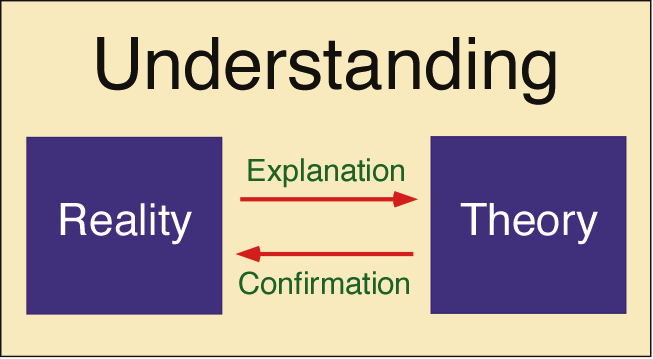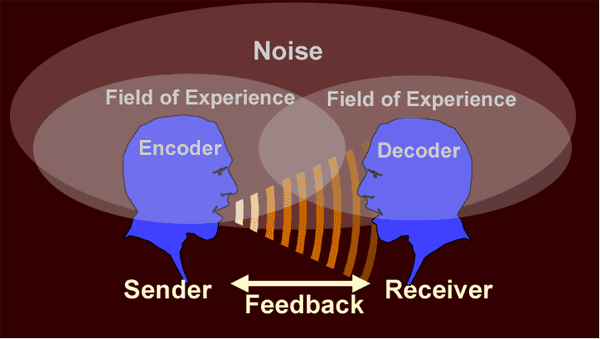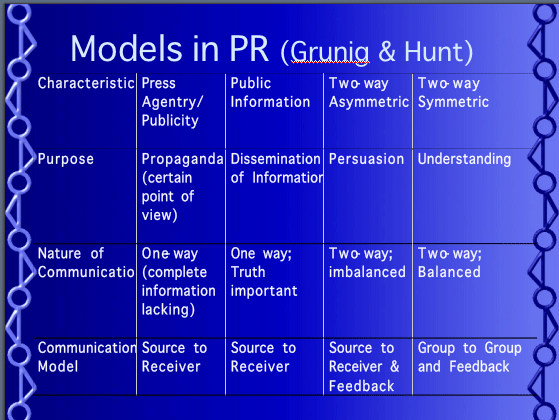
Communication
Theories in Public Relations
Dr. Iccha Basnyat
- What is theory?

- Communication Theory
- Early model focusing on one-way persuastive communication (Shannon
& Weaver, 1949)


- Early model focusing on one-way persuastive communication (Shannon
& Weaver, 1949)
- Communication Theories for PR
- Levels of communication:
- Interpersonal
- -- Attribution Theory; Persuasion; Situational Theory
- Group
- -- Groupthink; Decision Making
- Public/Mass
- -- Media Theories (i.e. Agenda Setting, Framing, Uses & Gratification)
- Organizational
- -- Assimilation Theory; Cultural
- -- Assimilation Theory; Cultural
- Interpersonal
- Levels of communication:
- Communication Theories in PR
- Structure, Operation & Interaction:
- Systems Theory
- Application for PR:
- Attribution Theory
- Situational Theory
- Persuasion Theory
- Agenda Setting & Framing
- Critical Theory
- Structure, Operation & Interaction:
- Systems theory
- System is an organized set of interrelated and interacting parts that maintain their own balance amid the influences of the environment
- Meaning:
- No one part can be understood unless it is viewed within the context of the entire system
- No one part with function fully without all the other parts
- Examples of system:
- i.e. Mechanical, Nature, Social
- i.e. Mechanical, Nature, Social
- Social Systems
- Sub-systems
- Multiple systems overlap
- Hierarchy of Systems
- Sub-systems
- Closed System
- Impermeable Boundary
- Doesn’t adapt to external change
- Static
- Eventually disintegrates
- i.e. Mechanics
- Reactive PR
- -- Active only when disturbed, reacting to crisis, problems
- -- Active only when disturbed, reacting to crisis, problems
- Elements of an Open Social System
- Interdependence:
- Interconnection: (i.e. domino effect)
- Adaptation:
- Continual Interaction with feedback (+ve/-ve)
- Homeostasis
- Morphogenesis
- Permeable Boundaries
- Equifinality
- Interdependence:
- PR in Open & Living System
- Proactive:
- Anticipate
- Scan & Monitor
- Early detection
- -- adjusts & initiates corrective changes
- -- adjusts & initiates corrective changes
- Proactive PR keeps organizational sensitive to environmental change
- Two-way symmetrical model
- -- Mutual dependent relationship/feedback
- Proactive:
- PR Theories
- Attribution Theory:
- 1958 Heider
- Explaining one’s own behavior and that of others
- Assigning attributes to explain behaviors
- How do we know what attributes will be used by each individual?
- Situational Theory (Grunig, 1984):
- Publics are identified & classified
- Passive vs. Active Public
- Latent Public
- -- PR practitioner must know what stimulus/triggers
- -- Right use of communication
- -- Normative Theory
- --Pre-selection of target population
- Triggers/Stimulus (Grunig) depends on:
- All-issue publics
- Apathetic publics
- Single-issue publics
- Hot-issue publics
- Assumption:
- Publics are equal partners when the relationship exists
- Power and Relationship missing from discussion
- Linear & Cognitive
- Public can be targeted & brought into action (agency?)
- Agenda Setting (1972/73, McCoombs & Shaw)
- Media (mainly news media) tell us what to think about
- We judge as important what’s important for media
- Media (i.e. tool) > Public for Policy (power of media?)
- -- Media coverage = Agenda priorities
- What happens if people are not exposed to the same media?
- Media Framing (stemmed from Agenda-Setting)
- Strategic/A way to:
- Shape attitudes & choice
- Suggest issue(s)
- -- Selection, emphasis & exclusion
- Do media reflect reality? Or Do media shape reality?
- Assumes: People are passive
- -- Focus attention on issue to get response
- -- Gruning’s Latent/Passive Public
- -- Is raising awareness enough for behavior?
- Framing in PR:
- -- Belief it’s as much what you as how you say it
- -- Designing persuasive messages
- -- Issues
- -- Gain (benefits) vs. Loss (Risk)
- -- Situation/Responsibility
- -- Attributes (i.e. Information Processing)
- Strategic/A way to:
- Persuasion
- Inducing change in belief, attitude, behavior
- -- History of Persuasion & PR
- It’s pervasive
- i.e. Recruiting student, Raising funds, Convincing friends/parents,
Presenting proposal, Campaigns
- -- Continuum: Interpersonal to Mass
- To what extent are we (as individuals) comfortable to go to persuade others
- Ramifications for the organization? Profession?
- Inducing change in belief, attitude, behavior
- Propaganda & Persuasion (differentiated via)
- 1. Intent
- 2. Free Will
- 3. Truth
- What are some ethical responsibilities for a person who uses
persuasion techniques to influence others?
- Persuasion assumes input of message >> leads to change
>> Passive Public:
- -- Choice of channels & message under control of persuader
- -- Media will affect everyone the same
- Is persuasion manipulative?
- Take into consideration what others expect of someone
with your social status, position, and level of expertise
- Take into consideration what others expect of someone
with your social status, position, and level of expertise
- Attribution Theory:
- Communication & Public Opinion
- How do theories apply to public opinion?
- Persuasion = strategy to affect public opinion
- Research gauges & identifies public
- -- Situational Theory = tailoring message
- -- Situational Theory = tailoring message
- Media = tool to disseminate information
- -- Using the media via agenda setting through framing of messages
- Persuasion = strategy to affect public opinion
- What are the ethical implications for attempting to systematically
shape perceptions?
- Public Opinion: Two common definitions
- “ Public Opinion is the sum of individual opinions on an issue affecting those individuals”
- “Public Opinion is a collection of view held by persons interested in the subject”
- Key: Self-interest
- If self-interest then how do we change or can we change opinions?
- -- i.e. Persuasion
- Self-interest >> Hard to change opinions
- If self-interest then how do we change or can we change opinions?
- Opinion Leaders as Catalyst:
- Formal opinion leader
- Due to positions such as elected officials, presidents of companies, board of directors
- Informal opinion leaders
- Peers
- Role models who are admired
- Source to Opinion Leader to public
- Formal opinion leader
- Media as “magic bullet”?
- -- Uniform, direct and immediate effect on everyone who receives the message from the media
- -- Mass communication, with the right message, could influence
people to do just about anything
- Critical Theory & PR
- Current theory incomplete >> missing its impact, context, power relations
- Behavior isn’t all rational
- Instead
- PR >> maintains privileged position for government &
corporations in society
- -- Dominate News >> maintain Status Quo
- -- Exclude minority voices
- So
- Is PR inherently tied to corporate interest?
- Is persuading, framing ethical aspects of public relations
practice?
- PR >> maintains privileged position for government &
corporations in society